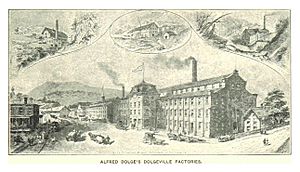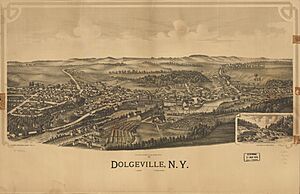Dolgeville, New York facts for kids
Quick facts for kids
Dolgeville, New York
|
|
|---|---|
| Country | United States |
| State | New York |
| Counties | Herkimer, Fulton |
| Towns | Manheim, Oppenheim |
| Area | |
| • Total | 1.83 sq mi (4.75 km2) |
| • Land | 1.79 sq mi (4.64 km2) |
| • Water | 0.04 sq mi (0.11 km2) |
| Elevation | 791 ft (241 m) |
| Population
(2020)
|
|
| • Total | 2,042 |
| • Density | 1,140.15/sq mi (440.33/km2) |
| Time zone | UTC-5 (Eastern (EST)) |
| • Summer (DST) | UTC-4 (EDT) |
| ZIP code |
13329
|
| Area code(s) | 315 |
| FIPS code | 36-20731 |
| GNIS feature ID | 948550 |
Dolgeville is a small village in New York, United States. It is located in both Herkimer and Fulton counties. In 2010, about 2,206 people lived there. The village is named after a famous businessman named Alfred Dolge.
Dolgeville is mostly in the eastern part of the town of Manheim. A small part is also in the western edge of the town of Oppenheim. It is located east of the city of Utica.
Contents
History of Dolgeville
How Dolgeville Started
The village began in 1794 when Samuel Low built two mills. A grist mill (for grinding grain) and a saw mill (for cutting wood) were built by Captain John Favill around 1795. Soon, more settlers arrived, and a small community grew. It had a blacksmith shop, a tannery (for making leather), and a school. Many families moved to the area and cleared land for farms.
Changing Names of the Village
In 1805, the area was first called "Green's Bridge." This was because a settler named Green built a bridge over East Canada Creek. In 1826, the first post office opened, and the area was renamed "Brockett's Bridge." This honored Zephi Brockett, who was the first postmaster.
In 1881, everyone living there asked to change the name again. They wanted to call it "Dolgeville." The village officially became Dolgeville in 1891.
Alfred Dolge's Impact
The village was renamed Dolgeville because of Alfred Dolge (1848–1922). He was a very important businessman who helped the area grow a lot. Dolge built many factories. He also built a railroad, planned the village layout, and created two schools. He even set up electricity, water, and sewage systems.
Alfred Dolge also started a fire department, a free library, a concert hall, and public parks. He even had a newspaper! He was a pioneer in offering pensions and profit-sharing for his workers. This meant his employees got money when they retired and shared in the company's success. Thomas Edison's first water-powered electric generator was even installed in Dolge's factory.
Dolge's factories mainly made parts for pianos. The Daniel Green shoe company later joined with Dolge. They found that the piano felt from Dolge's factory was also perfect for making slippers.
Later Years and Important Events
Sadly, Dolge's factories and social projects faced financial problems in 1899. The Dolge Company Factory Complex then became owned by the Daniel Green company. Daniel Green was the biggest employer in the village until 1999, when they closed their operations there.
Lyndon Lyon, who lived in Dolgeville until 1999, was very important for plant lovers. He developed about 800 new types of African violet flowers. He helped make them popular houseplants. Lyon's greenhouse in Dolgeville still operates today. It is famous for its violets and orchids. Dolgeville even has an annual Violet Festival to remember him.
In 1965, a caver (someone who explores caves) named James G. Mitchell got stuck in a cave near Dolgeville. He was trapped under a waterfall. Even though a team of cave rescuers arrived, Mitchell sadly died. This event became a national news story. It helped cavers learn more about the dangers of hypothermia (when your body gets too cold). Mitchell's body was finally found and returned to his family in 2006.
In late 2014, Alfred Dolge's large mansion from 1895 was destroyed by a fire. The cause of the fire is still unknown.
Several buildings in Dolgeville are listed on the National Register of Historic Places. These include the Breckwoldt-Ward House, Menge House Complex, Alfred Dolge Hose Co. No. 1 Building, Dolge Company Factory Complex, and the United States Post Office. Part of the Beaversprite nature preserve is also in the Fulton County area of Dolgeville.
Geography of Dolgeville
Dolgeville is located in the eastern part of Herkimer County and the western part of Fulton County. It covers about 1.83 square miles (4.75 square kilometers). Most of this area is land, with a small amount of water.
The main part of the village is in the northeastern corner of the town of Manheim. It sits on the west side of East Canada Creek. This creek flows south into the Mohawk River. The part of the village on the east side of the creek is in the town of Oppenheim. The northern end of the village, near the East Canada Creek, sometimes experiences flooding. Major floods happened in 2006, 2019, and 2022.
Two main roads meet in Dolgeville: New York State Route 29 and New York State Route 167. Route 29 goes east to Johnstown and west to Middleville. Route 167 ends in Dolgeville and goes southwest to Little Falls.
Population of Dolgeville
| Historical population | |||
|---|---|---|---|
| Census | Pop. | %± | |
| 1900 | 1,915 | — | |
| 1910 | 2,685 | 40.2% | |
| 1920 | 3,448 | 28.4% | |
| 1930 | 3,309 | −4.0% | |
| 1940 | 3,195 | −3.4% | |
| 1950 | 3,204 | 0.3% | |
| 1960 | 3,058 | −4.6% | |
| 1970 | 2,872 | −6.1% | |
| 1980 | 2,602 | −9.4% | |
| 1990 | 2,452 | −5.8% | |
| 2000 | 2,166 | −11.7% | |
| 2010 | 2,206 | 1.8% | |
| 2020 | 2,042 | −7.4% | |
| U.S. Decennial Census | |||
In 2000, about 2,166 people lived in Dolgeville. There were 915 households. About 29.8% of these households had children under 18 living with them. The average household had 2.35 people. The population was spread out, with many different age groups living in the village.
Economy of Dolgeville
The old Dolge factory complex is empty, even though people have tried to bring it back to life. However, other factories still operate in the village. A Rawlings factory in Dolgeville makes many of the baseball bats used by Major League Baseball. These bats are sold under the "Adirondack" brand. This factory also makes other wood products.
North Hudson Woodcraft Corp. used to make piano parts for Steinway pianos for over a hundred years. Now, they make other wood products like kitchen cabinets and caskets. Other companies in Dolgeville include Gehring-Tricot, which makes textile products. Tumbleforms and Bergeron By Design create products used in physical therapy.
Education in Dolgeville
The Dolgeville Central School District serves the village. The high school was built in 1954. An elementary school was added next to it in the 1980s. The old elementary school building on Main Street is now empty.
Media in Dolgeville
Most of Dolgeville gets its TV channels from the Utica area. They also read the Observer-Dispatch newspaper, which is from Utica. The small part of the village in Fulton County gets its TV channels from the Albany area. They read The Leader Herald newspaper from Gloversville. The The Times Telegram newspaper from nearby Herkimer also serves the entire village.
Notable people from Dolgeville
- Alfred Dolge (1848–1922), the businessman the village is named after
- Rudolf Ruedemann (1864–1956), a German-American scientist who studied fossils
- Henry I. Patrie (1874–1935), a businessman and politician
- Hal Schumacher (1910–1993), a baseball player
- Harold C. Luther (1915–1973), a politician
- John Neulinger (1924–1991), a psychologist
- Peter Fehlner (1931–2018), a Roman Catholic priest and writer, was born here.
Important groups in Dolgeville
- The North American Vegetarian Society has had its main office in Dolgeville since it started in 1974.
See also
 In Spanish: Dolgeville para niños
In Spanish: Dolgeville para niños





